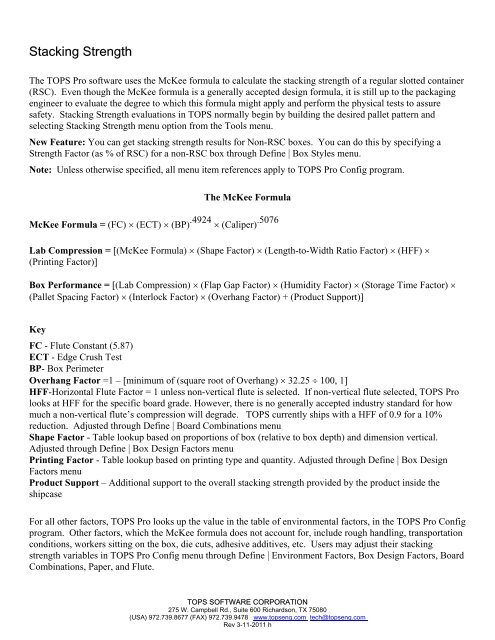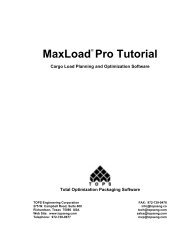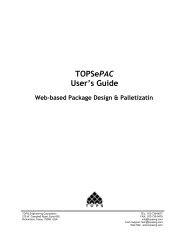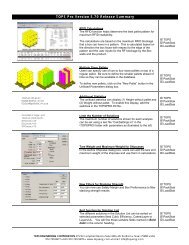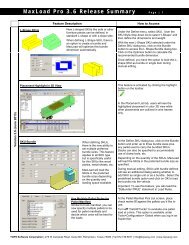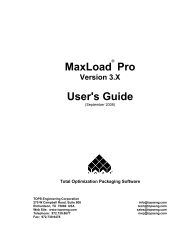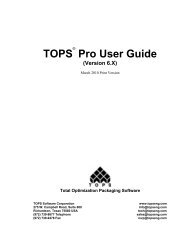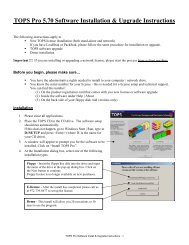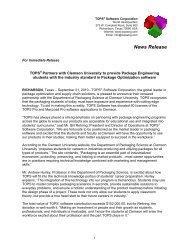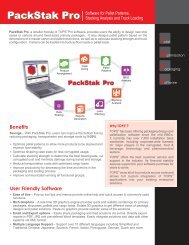Stacking Strength - TOPS - Packaging Software
Stacking Strength - TOPS - Packaging Software
Stacking Strength - TOPS - Packaging Software
You also want an ePaper? Increase the reach of your titles
YUMPU automatically turns print PDFs into web optimized ePapers that Google loves.
<strong>Stacking</strong> <strong>Strength</strong><br />
The <strong>TOPS</strong> Pro software uses the McKee formula to calculate the stacking strength of a regular slotted container<br />
(RSC). Even though the McKee formula is a generally accepted design formula, it is still up to the packaging<br />
engineer to evaluate the degree to which this formula might apply and perform the physical tests to assure<br />
safety. <strong>Stacking</strong> <strong>Strength</strong> evaluations in <strong>TOPS</strong> normally begin by building the desired pallet pattern and<br />
selecting <strong>Stacking</strong> <strong>Strength</strong> menu option from the Tools menu.<br />
New Feature: You can get stacking strength results for Non-RSC boxes. You can do this by specifying a<br />
<strong>Strength</strong> Factor (as % of RSC) for a non-RSC box through Define | Box Styles menu.<br />
Note: Unless otherwise specified, all menu item references apply to <strong>TOPS</strong> Pro Config program.<br />
The McKee Formula<br />
McKee Formula = (FC) × (ECT) × (BP) .4924 × (Caliper) .5076<br />
Lab Compression = [(McKee Formula) × (Shape Factor) × (Length-to-Width Ratio Factor) × (HFF) ×<br />
(Printing Factor)]<br />
Box Performance = [(Lab Compression) × (Flap Gap Factor) × (Humidity Factor) × (Storage Time Factor) ×<br />
(Pallet Spacing Factor) × (Interlock Factor) × (Overhang Factor) + (Product Support)]<br />
Key<br />
FC - Flute Constant (5.87)<br />
ECT - Edge Crush Test<br />
BP- Box Perimeter<br />
Overhang Factor =1 – [minimum of (square root of Overhang) × 32.25 ÷ 100, 1]<br />
HFF-Horizontal Flute Factor = 1 unless non-vertical flute is selected. If non-vertical flute selected, <strong>TOPS</strong> Pro<br />
looks at HFF for the specific board grade. However, there is no generally accepted industry standard for how<br />
much a non-vertical flute’s compression will degrade. <strong>TOPS</strong> currently ships with a HFF of 0.9 for a 10%<br />
reduction. Adjusted through Define | Board Combinations menu<br />
Shape Factor - Table lookup based on proportions of box (relative to box depth) and dimension vertical.<br />
Adjusted through Define | Box Design Factors menu<br />
Printing Factor - Table lookup based on printing type and quantity. Adjusted through Define | Box Design<br />
Factors menu<br />
Product Support – Additional support to the overall stacking strength provided by the product inside the<br />
shipcase<br />
For all other factors, <strong>TOPS</strong> Pro looks up the value in the table of environmental factors, in the <strong>TOPS</strong> Pro Config<br />
program. Other factors, which the McKee formula does not account for, include rough handling, transportation<br />
conditions, workers sitting on the box, die cuts, adhesive additives, etc. Users may adjust their stacking<br />
strength variables in <strong>TOPS</strong> Pro Config menu through Define | Environment Factors, Box Design Factors, Board<br />
Combinations, Paper, and Flute.<br />
<strong>TOPS</strong> SOFTWARE CORPORATION<br />
275 W. Campbell Rd., Suite 600 Richardson, TX 75080<br />
(USA) 972.739.8677 (FAX) 972.739.9478 www.topseng.com tech@topseng.com<br />
Rev 3-11-2011 h
Suggestion: To reduce chances of “no answers” when calculating, do not filter (by flutes, loads high,<br />
compression strength, or safety factor) until you have seen the resulting Boards Grades, and then filter out the<br />
extras.<br />
<strong>TOPS</strong> Pro <strong>Stacking</strong> <strong>Strength</strong> Results<br />
Field Descriptions<br />
Note: Board Combinations listed in blue color are acceptable stacking strength results<br />
A: Amount of weight that a box on the bottom layer of bottom pallet must support<br />
Lab Div: Lab Compression of the divider. This column appears if you have a divider<br />
specified. Each divider has a support factor that determines the amount of<br />
additional support that divider adds. (A support factor of 1 = no change.)<br />
Lab Box: Lab Compression of the box without the divider. This column appears if you<br />
have a divider specified<br />
Total Lab: Total Lab Compression = Lab Div + Lab Box<br />
Box Perf.: Box Performance. The resulting compression strength taking into account the<br />
environmental conditions you’ve specified.<br />
Safety Factor: Total Lab divided by the weight that the bottom case must support.<br />
Safety Factor = Lab Box / A<br />
Safety Margin: The percentage that the box performance exceeds the weight the bottom case<br />
must support. Boards with Safety Margins that are greater than zero are<br />
highlighted in blue.<br />
Safety Margin = (Box Perf – A) / A<br />
Load High: How many unitloads it takes to reach the limit (Box Perf) of a bottom-most case.<br />
ECT lbs/in: The ECT of the board. If the calculation method is Edge Crush, it will be the<br />
empirical value entered for each board in the <strong>TOPS</strong> Config program. If the<br />
<strong>TOPS</strong> SOFTWARE CORPORATION<br />
275 W. Campbell Rd., Suite 600 Richardson, TX 75080<br />
(USA) 972.739.8677 (FAX) 972.739.9478 www.topseng.com tech@topseng.com<br />
Rev 3-11-2011 h
calculation method is Ring Crush, <strong>TOPS</strong> will calculate the ECT from the Ring<br />
Crush Factor’s (RCF) of each board’s paper.<br />
Cost/1000 ft2: The cost per 1000 square feet as entered into the board grade database.<br />
Ring Crush to Edge Crush<br />
When entering a new Board combination and when using the "Ring Crush" calculation method, single and<br />
double wall ECT's are calculated from liner/medium ring crush factors.<br />
For Single Wall<br />
A= (Liner1 RCF) +(Liner2 RCF)+<br />
(Medium RCF)*(Flute TakeUp)<br />
For Double Wall<br />
A= (Liner1 RCF) +(Liner2 RCF)+(Liner3 RCF)+(Medium1 RCF)*(Flute TakeUp1)+(Medium2 RCF)*(Flute<br />
TakeUp2)<br />
Then if the combined weight of the outside liners is


